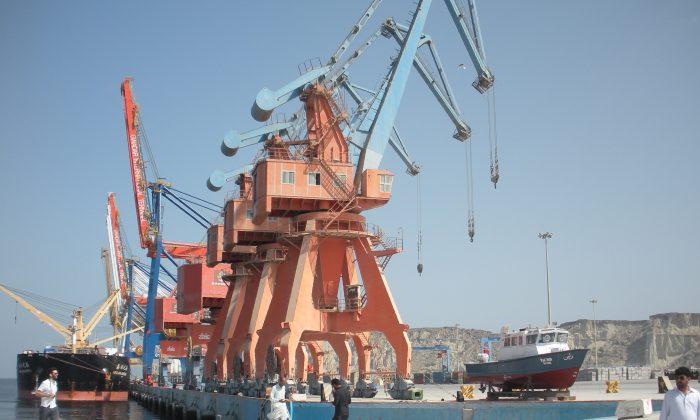The Belt and Road Initiative (BRI, also known as One Belt, One Road) is the Chinese regime’s imperialistic and expansionist agenda in large parts of Eurasia, South-Asia, and Africa. Dubbed as the “New Silk Road,” it connects China to Africa through seaways and highways. A flagship of the BRI is the China Pakistan Economic Corridor (CPEC), a collection of infrastructure projects that are currently under construction throughout Pakistan.
Originally valued at $46 billion, the CPEC project is estimated at $87 billion in funding today, only a quarter of which have been completed. CPEC was intended to rapidly modernize Pakistani infrastructure and strengthen its economy by the construction of modern transportation networks, numerous energy projects, and special economic zones (SEZs).
However, according to the Centre for Strategic and International Studies (CSIS), these SEZs remain largely empty today, and the long-standing challenges have only become more exacerbated. Facing unsustainable debt levels, growth rates down to 3 percent, five-year high inflation rates, and soaring deficits, Pakistan’s economy is definitely moving in the reverse direction.
CPEC is based on a false premise that a nation needs these massive economic projects to be prosperous. It’s apparent that no one is willing to pay for these projects in the end, as they will never make any money from them. Analysts have famously quoted: “These are bridges that don’t go anywhere. Some of the ambitious projects like a high-speed train from Beijing to Moscow will never have any takers.”
The debt quotient of this corridor is about $80 billion, 90 percent of which will be paid for by Pakistan in the form of national debt. Pakistan itself knows it won’t be able to pay China back and will slowly lose sovereignty of its own land. These projects don’t appear to have the potential to be profitable or successful and won’t prove to be a good economic investment for China.
Ultimately, this is a Chinese “colonial” adventure that will never bear fruit. There have been many reports out of China that indicate the Pakistani government itself is trying to sabotage the CPEC project. Chinese officials have been recorded as being incredibly frustrated with Pakistan’s actions or lack thereof so far. Like most adventures, there is no transparency, China sets the price, Pakistan gets the bill, and ends up with a sub-standard infrastructure it can’t service.
The Chinese regime is famous for its debt-trap diplomacy and loans in exchange for sovereignty. It believes in the tribute system now disguised as the BRI. It is already starting to take shape as the “trillion-dollar blunder.”
There are a number of criticisms of CPEC, namely finances, trade imbalances, Baloch nationalists, concerns of the Gwadahar port residents, and the resistance of local actors whom this rollout may directly affect. Another big setback is the resolution passed against CPEC by the Provincial Assembly of Khyber Pakhtunwah Province in which the projects are to be constructed. However, now there is a new legal issue that China will need to overcome. And this is where India comes in.
CPEC could be deemed illegal in international legal terms. After the abrogation of Article 370 by the government of India in August 2019, there was also a bifurcation of the state of Jammu and Kashmir into two union territories.
This changes the landscape of Indian sovereignty throughout the entire state of Jammu and Kashmir. The area of Kashmir that has been illegally occupied by Pakistan since 1947 is known as “Pakistan-occupied Kashmir” (PoK). This also includes the area of Gilgit-Baltistan.
The new reconfiguration of Kashmir gives more power to the central government of India, weakening the Pakistani arms of influence that are known to fund indoctrination, separatist movements, and terrorism. Kashmir will now follow the Indian constitution, its flag, and anthem. In a sense, the whole of Jammu and Kashmir is intact and merges back with the Indian republic.
Following international law, China will not be able to build anything in this PoK area, as it is legitimately part of the Indian state. Even the United Nations accepts that this is Indian land first as per the 1948 resolution.
As far as the Chinese regime is concerned, the more powerful it gets, the more arrogant and aggressive it becomes. It wants a hegemonic Asia without any peer competitors. The regime sees India as its main competitor, not just in the region, but also in the world at large.
Unlike India, which wants to see open seas, sound digital economy, renewable energy, and a stable region, China isn’t interested in a multipolar Asia. Although the two share a working trade relationship, trade will never bring peace, and the trust deficient factor on the Indian side is enormous.
The most important relationship in the second half of this century will be that of India and China. Will this be based on cooperation and a rule-based relationship or the beginning of a Himalayan cold war?
The recent stand-off between the two along the Line of Actual Control (LAC) in Ladakh is where the Chinese were seen to be building up with armor and troops on their side of the LAC. This is a new India that isn’t willing to accept infiltration into its territory.
The latest stand-off in Galwan Valley, Ladakh, a legitimate Indian territory, which claimed the lives of at least 20 Indian soldiers and up to 100 Chinese soldiers, has been highly explosive and will call for the highest levels of diplomatic negotiations between both countries.
Due to China’s presence in international territory, there may have been violations of the Vienna conventions. India will see this as an opportunity to show the world that it will protect its territorial integrity and has the capacity to give China a bloody nose.
It seems that the CPEC “colonial” adventure has failed before it has even begun. In a way, the Chinese strategy for land encroachment and Pakistan’s gluttonous desire for land grabbing may end up being its own downfall.


Friends Read Free